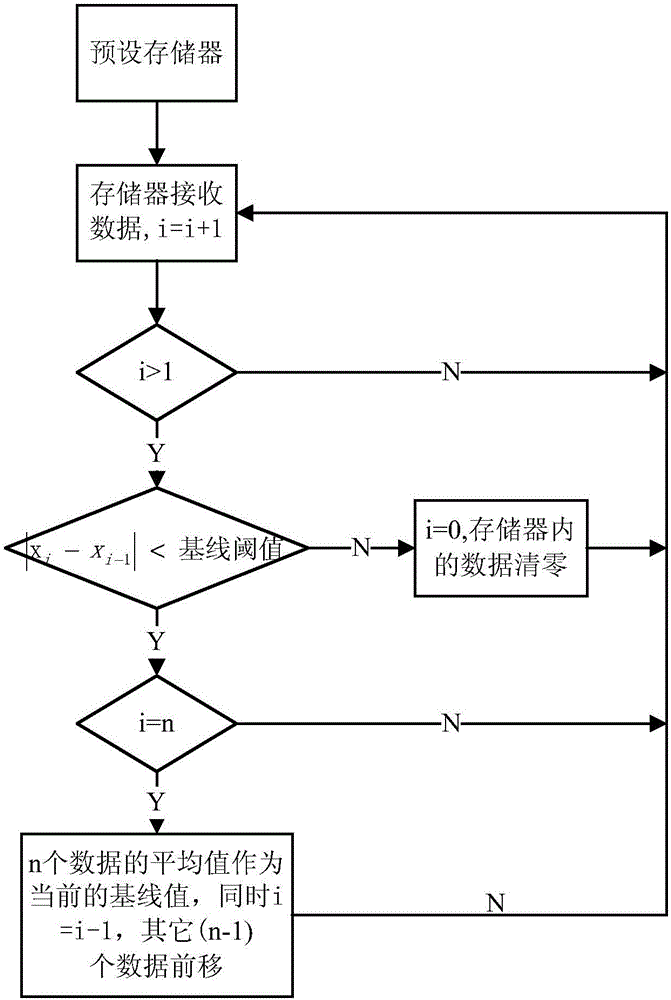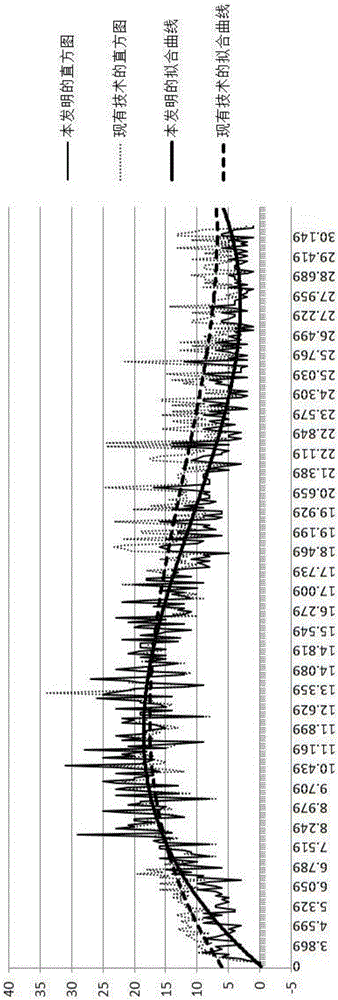Pulse baseline value calculation method and particle counting method for blood cell analyzer
A technology of pulse baseline and calculation method, which is applied in the fields of calculation, analysis of materials, individual particle analysis, etc., can solve the problem that it is difficult to avoid noise interference in baseline value calculation, and achieve the effect of reducing misjudgment and accurate particle counting.
- Summary
- Abstract
- Description
- Claims
- Application Information
AI Technical Summary
Problems solved by technology
Method used
Image
Examples
Embodiment 1
[0078] figure 2 It is a voltage curve graph with downward interference during the platelet detection process, where the abscissa is the number of sampled data, the ordinate is the measured voltage amplitude, and the pulse peak x 34 The size of 413, table 1 is figure 2 Sample data x in 1 -x 50 The specific value of , the data includes the sampling data in the non-duration period of the pulse and the sampling data in the duration of the pulse. Let's take the specific sampling data as an example, with the value of n being 8, the baseline threshold being 20, and the data x 22 is the starting point of the pulse, indicating the calculation steps of the pulse baseline value:
[0079] 1) Preset memory, the memory is used to store 8 continuous sampling data;
[0080] 2) During the non-duration of the pulse, the memory receives the sampling data x 1 , the value i of the data stored in the memory is accumulated by 1, that is, i=1, i<1;
[0081] 3) The memory receives the samplin...
Embodiment 2
[0111] Figure 4 It is a voltage curve graph with upward interference during the red blood cell detection process, where the abscissa is the number of sampled data, the ordinate is the measured voltage amplitude, and the pulse peak x 36 The size of is 1314, the value of n is 8, the baseline threshold is 20, and the data x 23 Calculated for pulse start. Table 3 is Figure 4 Sample data x in 1 -x 50 The specific value of , the data includes the sampling data in the non-duration period of the pulse and the sampling data in the duration of the pulse. By calculation, the data range of the sampled data is obtained in x 10 to x 17 satisfies the requirements for calculating the baseline value, therefore, x 10 to x 17 The average value of the 8 data in 238.12 is the baseline value of the current pulse.
[0112] sequence
x 1 -x 10
x 11 -x 20
x 21 -x 30
x 31 -x 40
x 41 -x 50
1
183
237
262
599
525
2
1...
Embodiment 3
[0132] Figure 6 It is a voltage curve graph with downward interference during the red blood cell detection process, where the abscissa is the number of sampled data, the ordinate is the voltage amplitude, and the pulse peak x 32 The size of 884, Table 5 is Figure 6 Sample data x in 1 -x 45 The specific value of , the data includes the sampling data in the non-duration period of the pulse and the sampling data in the duration of the pulse. Taking the specific sampling data as an example, the value of w is 7, and the starting point threshold is 40 for calculation to illustrate the calculation steps of the pulse starting point:
[0133] 1) A memory is provided, and the memory is used to store 8 continuous sampling data;
[0134] 2) The memory receives and stores the sampling data y 1 =x 1 =121, the value j of stored data in the memory is accumulated by 1, i.e. j=1;
[0135] 3) The memory receives data y 2 =x 2 = 112, j = 2, y 2 1 , the memory receives data y 3 =x 3 ...
PUM
 Login to View More
Login to View More Abstract
Description
Claims
Application Information
 Login to View More
Login to View More - R&D
- Intellectual Property
- Life Sciences
- Materials
- Tech Scout
- Unparalleled Data Quality
- Higher Quality Content
- 60% Fewer Hallucinations
Browse by: Latest US Patents, China's latest patents, Technical Efficacy Thesaurus, Application Domain, Technology Topic, Popular Technical Reports.
© 2025 PatSnap. All rights reserved.Legal|Privacy policy|Modern Slavery Act Transparency Statement|Sitemap|About US| Contact US: help@patsnap.com



